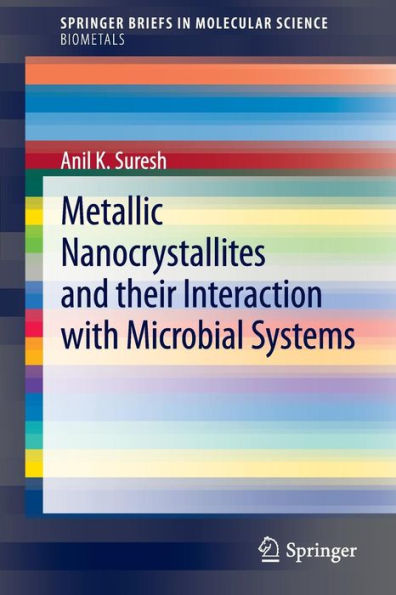Metallic Nanocrystallites and their Interaction with Microbial Systems
Although interactions between nanoparticles and microorganisms in the environment are unavoidable and commonplace, it is still not clear what potential effects they may have. Metallic Nanocrystallites and their Interface with Microbial Systems not only illustrates how microbes and these particular nanoparticles interact but also it describes the consequences of these interactions. This brief discusses the impact of gold, silver, zinc oxide, and cerium oxide nanoparticles on the growth and viability of both Gram-negative and Gram-positive bacterium. Moreover, it analyses the relationship between bacterial growth inhibition, reactive oxygen species generation, the regulation of transcriptional stress genomes, and the toxicity of these materials. Finally, it reviews the specific metallic nanomaterials and highlights their modes of synthesis, reactivity at surfaces, and the importance of assay procedures in determining their toxicity levels. Various microscopy techniques used to determine their mechanisms of action are also presented. Metallic Nanocrystallites and their Interface with Microbial Systems will be a valuable source to the scientific and industrial community as well as to students and researchers in microbiology, biotechnology, nanotechnology, toxicology, materials science, biomedical engineering, cell and molecular biology.
1108643118
Metallic Nanocrystallites and their Interaction with Microbial Systems
Although interactions between nanoparticles and microorganisms in the environment are unavoidable and commonplace, it is still not clear what potential effects they may have. Metallic Nanocrystallites and their Interface with Microbial Systems not only illustrates how microbes and these particular nanoparticles interact but also it describes the consequences of these interactions. This brief discusses the impact of gold, silver, zinc oxide, and cerium oxide nanoparticles on the growth and viability of both Gram-negative and Gram-positive bacterium. Moreover, it analyses the relationship between bacterial growth inhibition, reactive oxygen species generation, the regulation of transcriptional stress genomes, and the toxicity of these materials. Finally, it reviews the specific metallic nanomaterials and highlights their modes of synthesis, reactivity at surfaces, and the importance of assay procedures in determining their toxicity levels. Various microscopy techniques used to determine their mechanisms of action are also presented. Metallic Nanocrystallites and their Interface with Microbial Systems will be a valuable source to the scientific and industrial community as well as to students and researchers in microbiology, biotechnology, nanotechnology, toxicology, materials science, biomedical engineering, cell and molecular biology.
49.95
In Stock
5
1

Metallic Nanocrystallites and their Interaction with Microbial Systems
67
Metallic Nanocrystallites and their Interaction with Microbial Systems
67Paperback(2012)
$49.95
49.95
In Stock

Product Details
| ISBN-13: | 9789400742307 |
|---|---|
| Publisher: | Springer Netherlands |
| Publication date: | 03/02/2012 |
| Series: | SpringerBriefs in Molecular Science |
| Edition description: | 2012 |
| Pages: | 67 |
| Product dimensions: | 6.10(w) x 9.25(h) x 0.01(d) |
About the Author
From the B&N Reads Blog
